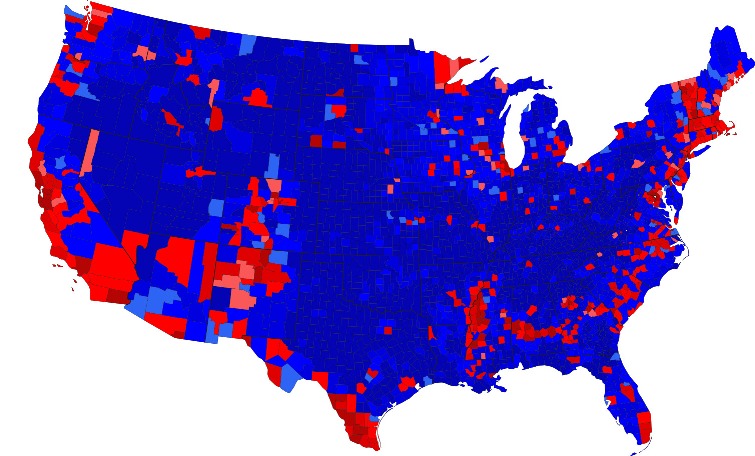What's in a Color?
Map colors, the right way:

The colors we use in our maps aren't wrong, they're traditional (some folks think those words mean the same thing) and unlike certain other political sites which use traditional coloration, we see no need to apologize or make excuses for it.

Before the Presidential election of 2000, blue was commonly used for the Republican party on election maps and red was Democrat, the latter being traditional for political parties of the left in other countries — the Labour Party in England, the Liberal Party in Canada among many examples, and one-party leftist states such as the Soviet Union, Communist China and of course National Socialist Germany.
Even prior to 2000 the leftist U.S. media was uncomfortable with the obvious assocation between Democrats and the color red and occasionally took measures to break that association. According to the left-wing site "electoralvotemap.com":
In Cold War America, the television networks couldn't consistently identify one party as "red" - it was the color of communists, after all - without being accused of political bias. So depending on the election or the network, red and blue states were variously assigned to Democrats and Republicans.Beginning in 2000 the colors were no longer "variously assigned". Not only were the U.S. political party colors abruptly reversed from what they had been most of the time since 1972, but that reversal was done uniformly and simultaneously across all of the so-called mainstream media. The new arrangement which was imposed was then cemented into place by making the color assignments part of the language as they never were before. Tim Russert has been credited by some with coining the terms "red state" and "blue state", or at least being the first to use those descriptions on the air during coverage of the 2000 Presidential election.
Regardless of who got the ball rolling, the new terms immediately propagated throughout the media; the obvious idea was to permanently divorce the Democrat party from its "color"-ful association with other parties of similar unpopular ideology and to affix that undesirable color to the Republicans forever after. The media's goal remains obvious to most people, but the liberal opinion-makers still won't admit it. One amusing explanation comes from an article published in 2012 on the left-wing website "The Verge", which declares:
The color coding we're familiar with today didn't stick until the iconic (and extremely lengthy) election of 2000, when The New York Times and USA Today published their first full-color election maps.After 12 years they couldn't think of a better excuse than that? The actual "natural association" was the one from which they desperately wanted to escape.
The Times spread used red for Republicans because "red begins with r, Republican begins with r," said the senior graphics editor Archie Tse, "it was a more natural association."
The election, which didn't end until mid-December, firmly established Democrats as the blue party and Republicans as the red — denotations which will likely hold fast for some time to come.


Psychology: Another Important Reason For Swapping Colors
According to a website called "colorpsychology.org":
"The impact that colors have on our brains is used to manipulate our decision making by multiple facets of society."Attempting to "manipulate our decision making" is what the media is all about, whether the decision is about which deodorant or breakfast cereal to purchase or which candidate they want us to vote for (or against).
"Color psychology is a very important tool used as a marketing mechanism in many industries."
Colorpsychology.org provides a listing of the traits associated with colors and the psychological and physiological effects those colors are intended to have.
Red
- Associated with energy, war, danger, strength, power, determination as well as passion, desire, and love.
- Enhances human metabolism, increases respiration rate, and raises blood pressure.
Some nice-sounding words are in there along with the scary ones, but qualities such as strength, power and determination are not necessarily viewed in a positive light, particularly when those words are associated with one's political opponents. Strength and power smack of what Generation Snowflake calls "toxic masculinity", and that's hardly what they're looking for in a political candidate.
Blue
- Unique and authentic.
- Enthusiastic, sympathetic and personal; they seek meaning and significance in life.
- Warm, communicative and compassionate; they care about what they do.
- Idealistic, spiritual and sincere; they value unity and integrity in their relationships.
- Peaceful, flexible and imaginative; they are natural romantics and nurturers.
That's one great color! No wonder those in the media selected it for their allies. It doesn't matter whether those lovely Blue traits bear no resemblance whatsoever to Nancy Pelosi, Adam Schiff, Jerrold Nadler, Chuckie Schumer, et al. What does matter is that people are subconsciously influenced in a positive way by that particular color which the media and other Democrats have cleverly assigned to their party for all eternity, and it matters just as much that people are influenced in a negative way by the color which the media and other Democrats have assigned to their enemies.